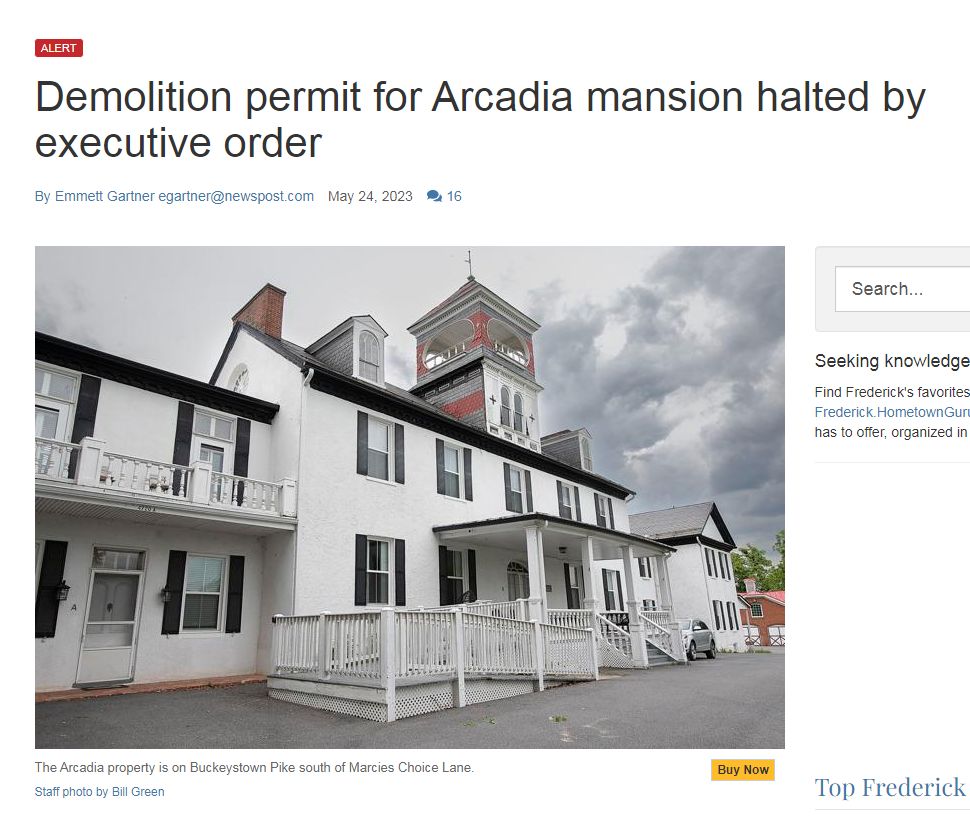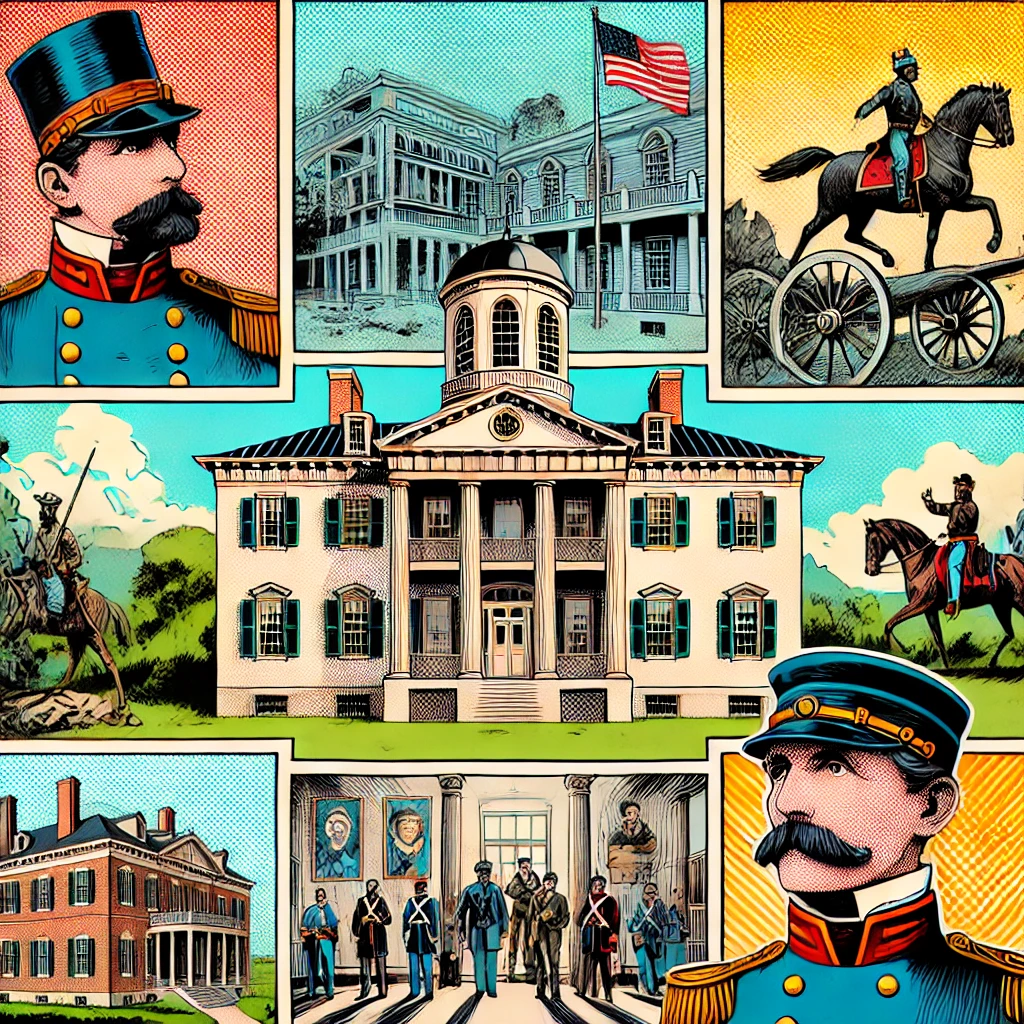Arcadia Mansion Frederick county Maryland
45-room mansion on the Monocacy battlefield. Rt. 85 near Frederick.
GOOGLE MAP
https://www.google.com/maps/place/Arcadia/@39.3631759,-77.4211989,867m
Update 2023 — Demolition halted

Arcadia Mansion: Maryland’s Haunted History and Paranormal Mystique
Nestled in the rolling hills of Frederick County, Maryland, Arcadia Mansion is a historic gem steeped in beauty, intrigue, and ghostly whispers of the past. While its architecture and Civil War significance are well-documented, the mansion has also become a focal point for paranormal enthusiasts and historians alike.
In this blog post, we’ll explore Arcadia Mansion’s storied history, its connections to the Civil War, mysterious deaths, and the supernatural lore that continues to captivate visitors.
A History Steeped in Significance
Arcadia Mansion, built in the late 18th century, originally showcased Federal-style architecture, later transformed by Victorian modifications that added a striking Queen Anne tower and ornate details. Its location in Frederick County placed it at the heart of some of the most turbulent moments in American history.
Civil War Connections
The mansion’s strategic location made it a key site during the Civil War:
- General George Meade’s Headquarters: Before the pivotal Battle of Gettysburg, the mansion served as a command post for General Meade, shaping the course of history.
- Battle of Monocacy: Confederate General Jubal Early is said to have staged his troops on the property’s grounds, leading to an infamous clash nearby.
- Colonel William Pendleton’s Artillery Camp: Arcadia was a resting point for Confederate artillery en route to Antietam.
These historical events are well-documented, but they left more than just marks on the pages of history—they seem to have left imprints of the souls involved.
Deaths and Tragedy
While war brought its own share of death to the property, Arcadia Mansion’s history is peppered with accounts of untimely and mysterious deaths:
- Unmarked Graves: Local lore speaks of unmarked graves scattered across the estate, possibly belonging to soldiers, servants, or early inhabitants.
- The Lady of the Tower: A tragic tale recounts a young woman who fell—or was pushed—from the Queen Anne tower. Visitors claim her restless spirit still roams the grounds, forever seeking answers.
Paranormal Lore and Sightings
Arcadia Mansion’s storied past has given rise to numerous tales of ghostly encounters and supernatural phenomena. Paranormal investigators and visitors have reported the following:
The Phantom Soldiers
Many guests describe hearing the muffled sounds of marching boots, the clinking of canteens, and the distant hum of wartime songs. Some have even claimed to see spectral soldiers in full uniform wandering the grounds.
Mysterious Lights
At night, eerie orbs of light have been seen flickering in the mansion’s windows and across the surrounding fields. Skeptics suggest natural explanations, but locals believe they are the lanterns of lost spirits searching for home.
Whispering Voices
Several visitors report hearing disembodied whispers in the hallways, often calling out names or reciting prayers. These voices seem to be tied to the mansion’s Civil War history, with one investigator recording what they believed to be a soldier’s plea for water.
Poltergeist Activity
The dining room is rumored to host a mischievous spirit known to rearrange chairs and knock over candlesticks. Many attribute this activity to a servant who met an untimely end in the mansion’s basement.
Historical and Paranormal Tourism
Arcadia Mansion has become a hotspot for history buffs and paranormal investigators alike. Guided tours often blend historical facts with spine-chilling accounts of hauntings. Special events like ghost hunts and Civil War reenactments draw crowds eager to experience the mansion’s eerie charm.
Preserving the Legacy
Efforts to preserve Arcadia Mansion have faced challenges, including a demolition scare in 2023. Thankfully, advocates succeeded in halting its destruction, recognizing the site’s cultural and historical value. Today, it stands as a reminder of Maryland’s complex past, inviting those brave enough to uncover its secrets.
Conclusion: A House with Stories to Tell
Whether you’re drawn by its rich Civil War history, architectural splendor, or the promise of a ghostly encounter, Arcadia Mansion offers a glimpse into a world where the past and present collide. Its haunting beauty is a testament to the lives—and perhaps the spirits—that have passed through its halls.
If you’ve visited Arcadia Mansion and have a story to share, we’d love to hear from you. Drop your experiences in the comments below, and let’s keep the lore alive!
from the Maryland Historical Trust
Property name: Arcadia
Date Listed: 8/3/1978
Inventory No.: F-1-172
Location: Cloverleaf Drive, Frederick, Frederick County
Significance: Arcadia Mansion is significant for its role in the Civil War. Because of General Lee’s invasion of Maryland prior to the Battles of South Mountain and Antietam, Colonel Pendleton stayed at Arcadia after his journey from Leesburg and bivouacked his artillery along Ballenger Creek.
The mansion also served as General Meade’s headquarters when he superceded General Hooker. From there, he marched his troops to Gettysburg. General Early formed his troops at Arcadia for an assault on Washington. However, they were opposed by General Wallace, and the Confederates were delayed in their march on Washington, possibly saving the city from destruction.
After the battle, Confederate wounded were taken to Arcadia. Dr. David McKinney, the surgeon in charge of the Federal hospital across the creek at the Markell Estate, was so impressed with the mansion and surrounding area that he purchased it from Robert McGill in 1865.
Arcadia Farm remained in the McKinney family until 1968. Arcadia is a large structure situated on a hill, dominating the surrounding landscape. The original house is not readily apparent since there have been additions and extensive remodeling during the latter part of the 19th century.
The interior is Victorian as is the exterior trim and the tower. One wing is consistent with the main house in design; the other was later modernized, probably in the 1890s, by the addition of a two-story bay window to the front and a mansard roof. Adjacent to the mansion is a fine, well-designed small barn and/or carriage house.
Thus, Arcadia is significant for its historical associations and as an interesting mix of architectural features which have become a local landmark.
Description: Arcadia is a 45-room mansion overlooking the Monocacy Battlefield. Finished with white stucco, Arcadia now has a five-part Palladian form with a 2 1/2-story five-bay gable-roofed main block connected to 2 1/2-story hip-roofed pavilions by 2-story hyphens.
The original house, reportedly built around 1790, has been obscured by Victorian additions and renovations. The exterior surface of Arcadia has relatively little decoration. The north wing and the main block have a heavy Victorian cornice. A Queen Anne tower with polychrome slate sides and pyramidal roof were added to the roof over the main entrance.
To either side is a gable-roofed dormer with a round-arched window with tracery. Three such dormers appear on the rear roof slope. A porch with square posts and a balustrade covers the central entrance and one bay to each side of the front facade. The hyphens were originally one story, and a second floor was added to the north pavilion reportedly by Dr. David McKinney who purchased the house in 1865.
The southern pavilion has been extensively altered by the addition of a two-story bay window which covers the entire front. Neither the arched openings in the bay nor its mansard roof with circular windows are repeated in the rest of the house. Other openings are rectangular, and the roofs have patterned slate shingles. Some windows retain their 6/6 pane sash, but some have been changed to 2/2.
On each side of the main block are interior chimneys with flues that arch in the gable ends to form a massive stack. In each gable is a large rose window with clear glass. The interior of Arcadia was extensively and elaborately Victorianized. The main entrance hall is divided by an elliptical arch visually supported by slender pilasters on pedestals. Doors from the parlor and dining room have paneled transoms.
Throughout, there are wood mantels. Those on the first floor have a shelf supported on each side with a slender column. The stair hall is adjacent to the dining room and perpendicular to the main hall. Its dogleg stair with oak balusters has a massive newel post. In the southern pavilion there is an arched marble fireplace which retains its large gold-framed overmantel mirror.
Arcadia retains several outbuildings. To the rear of the house is a brick building and a stone one. North of the house is a fine brick carriage house with segmental arched openings and a tin jerkinhead roof.
Arcadia Mansion: A Historic Gem in Frederick County, Maryland
Nestled between Frederick and Buckeystown, Maryland, Arcadia Mansion stands as a testament to the region’s rich history and architectural evolution.
Architectural Overview
Constructed around 1790, Arcadia Mansion originally showcased a Federal-style design. Over the years, particularly in the late 19th century, the mansion underwent significant Victorian-era modifications. Notable additions include:
- Queen Anne Tower: A distinctive balconied tower enhancing the mansion’s grandeur.
- Palladian Form: The structure now exhibits a five-part Palladian layout, featuring a central two-and-a-half-story gable-roofed main block connected to two-and-a-half-story hip-roofed pavilions by two-story hyphens.
- Victorian Cornices and Dormers: Decorative elements such as heavy Victorian cornices and gable-roofed dormers with round-arched windows add to its architectural charm.
Civil War Significance
Arcadia Mansion played a pivotal role during the Civil War:
- Colonel William Pendleton’s Stay: Prior to the Battle of Antietam, Colonel Pendleton stayed at Arcadia after his journey from Leesburg, bivouacking his artillery along Ballenger Creek.
- General George Meade’s Headquarters: The mansion served as General Meade’s headquarters before the Battle of Gettysburg.
- General Jubal Early’s Formation Ground: During the Battle of Monocacy, General Early formed his troops at Arcadia for an assault on Washington.
Preservation Efforts
In March 2023, Frederick County issued a demolition permit for Arcadia Mansion. However, two months later, county executives temporarily halted the demolition, recognizing the mansion’s historical significance.
Current Status
Today, Arcadia Mansion offers a unique blend of historical allure and modern hospitality. Portions of the mansion have been renovated into separate units available for short-term rentals, allowing guests to experience its storied past firsthand.
Conclusion
Arcadia Mansion stands as a symbol of Maryland’s architectural heritage and historical significance. Its preservation ensures that future generations can appreciate and learn from its rich past.
